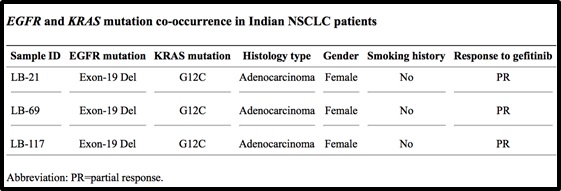
When KRAS mutations co-occurs with EGFR in lung cancer
Clinical collaborator: Dr. Kumar Prabhash (TMH)EGFR mutations that occur at 10-15% among Caucasians and 30-60% among East Asians contrasts with KRAS mutations incidence that more commonly affect Caucasians with a frequency of 25% to 50% compared to 5% to 15% among East Asians. We recently, reported an intermediate frequency of 23% EGFR mutations in a study involving 907 Indian NSCLC patients with 74% response among patients harboring EGFR mutations compared to 5% with wild type EGFR in a smaller set of 111 Indian NSCLC patients. EGFR and KRAS mutations occur mutually exclusive in NSCLC, which suggests functional redundancy, however they predict contrasting response rate to tyrosine-kinase inhibitors (TKI). While EGFR mutation predicts longer progression-free survival rate, adverse prognosis is associated with patients harboring KRAS mutations. Here, we perform directed sequencing of KRAS exon 2 and 3 across 86 patients. We find 17 patients with KRAS G12C and 1 patient with KRAS G12V mutation of 86 NSCLC patients with an overall mutation rate of 20.4%, which is of an intermediate frequency compared to KRAS mutation incidence in Caucasians and East Asians. Here, we describe co-occurrence of EGFR with KRAS mutations in NSCLC patients with their clinical outcome to EGFR inhibitor therapy, as summarized below.

[EGFR and KRAS mutation co-occurrence in Indian NSCLC patients]
[BJC]